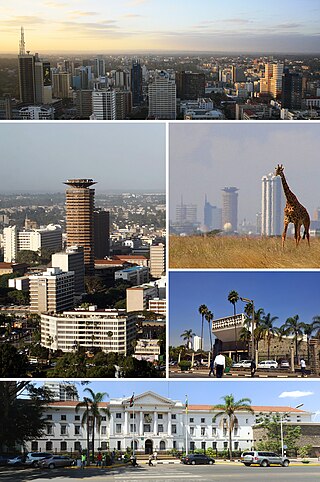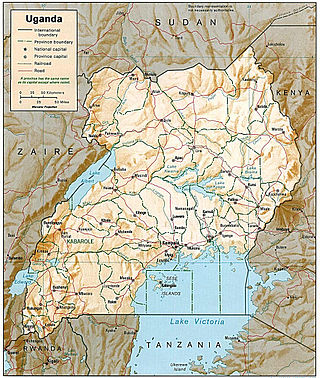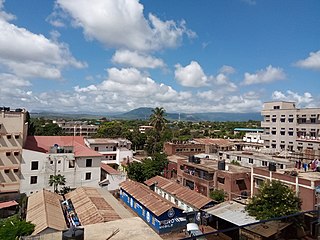There are a number of systems of transport in Burundi, including road and water-based infrastructure, the latter of which makes use of Lake Tanganyika. Furthermore, there are also some airports in Burundi.

Nairobi is the capital and largest city of Kenya. The name is derived from the Maasai phrase Enkare Nairobi, which translates to 'place of cool waters', a reference to the Nairobi River which flows through the city. The city proper had a population of 4,397,073 in the 2019 census. The city is commonly referred to as The Green City in the Sun.

Transport in Uganda refers to the transportation structure in Uganda. The country has an extensive network of paved and unpaved roads.

The Uganda Railway was a metre-gauge railway system and former British state-owned railway company. The line linked the interiors of Uganda and Kenya with the Indian Ocean port of Mombasa in Kenya. After a series of mergers and splits, the line is now in the hands of the Kenya Railways Corporation and the Uganda Railways Corporation.

Kisumu is the third-largest city in Kenya after the capital, Nairobi, and Mombasa. It is the second-largest city after Kampala in the Lake Victoria Basin. The city has a population of slightly over 600,000. The metro region, including Maseno and Ahero, has a population of 1,155,574 people according to the 2019 Kenya Population and Housing Census which was conducted by the Kenya National Bureau of Statistics.

Lake Victoria ferries are motor ships for ferry services carrying freight and/or vehicles and/or passengers between Uganda, Tanzania, and Kenya on Lake Victoria.

Voi is the largest town in Taita-Taveta County in southern Kenya, in the former Coast Province. It lies at the western edge of the Taru Desert, south and west of the Tsavo East National Park. The Sagala Hills are to the south.

Kenya Railways Corporation (KRC), also Kenya Railways (KR) is the national railway of Kenya. Established in 1977, KR is a state corporation.

The Uganda Railways Corporation (URC) is the parastatal railway of Uganda. It was formed after the breakup of the East African Railways Corporation (EARC) in 1977 when it took over the Ugandan part of the East African railways.

Rift Valley Railways (RVR) was a consortium established to manage the parastatal railways of Kenya and Uganda. The consortium won the bid for private management of the century-old Uganda Railway in 2005. The Kenya-Uganda railway had previously been run by the East African Railways and Harbours Corporation over the period 1948–77. In 2014, RVR moved 1,334 million net tonne kilometers of rail freight, up from 1,185 million net tonne kilometers the previous year. Both Kenya and Uganda terminated their contracts with RVR in mid-2017, with control of their national rail networks reverting to the Kenya Railways Corporation and the Uganda Railways Corporation, respectively.
Rail transport in Kenya consists of a metre-gauge network and a new standard-gauge railway (SGR). Both railways connect Kenya's main port city of Mombasa to the interior, running through the national capital of Nairobi. The metre-gauge network runs to the Ugandan border, and the Mombasa–Nairobi Standard Gauge Railway, financed by a Chinese loan, reaches Suswa.
The Northern Corridor Transit and Transport Coordination Authority (NCTTCA) is an intergovernmental body, encompassing six countries in Eastern Africa, tasked with the job of coordinating transport infrastructure improvements.

Embakasi, also known as Eastlando by its local youth residents, is a neighbourhood in the city of Nairobi. It is approximately 18 kilometres (11 mi), southeast of the central business district. Embakasi is considered part of Nairobi's Eastlands area, lying to the south-east of Nairobi County. The Embakasi proper covers other estates in Eastlands such as Donholm, Pipeline, Tena, and Makadara estates. It borders South C and contains South B and slightly more than one third of Nairobi's Industrial Area and Export Processing Zones.
There are several planned railway lines in Rwanda, including a line to Tanzania. Historical railways are limited to three industrial railways.

The East African Railway Master Plan is a proposal for rejuvenating the railways serving Tanzania, Kenya, and Uganda, and building new railways to serve Rwanda and Burundi. The objective is to further the economic development of East Africa by increasing the efficiency and speed, and lowering the cost, of transporting cargo between major ports on the Indian Ocean coast and the interior.

South Sudan does not have an extensive rail system. Current rail infrastructure, which was constructed between 1959–1962, and was left over from the previous Sudan government is in a serious state of disrepair. It consists of a 248 kilometers (154 mi) narrow-gauge, single-track line that connects Babonosa (Sudan) with the city of Wau in South Sudan. The line was left in poor condition after the Second Sudanese Civil War after several parts of it were mined; the line was fully rehabilitated with United Nations funds.
Syokimau is a residential area in the west of Machakos County, Kenya, just south of Nairobi and Jomo Kenyatta International Airport.
The Mombasa–Nairobi Standard Gauge Railway, completed in 2017, was built as the first phase of the Kenya Standard Gauge Railway. It is a standard-gauge railway (SGR) in Kenya that connects the large Indian Ocean city of Mombasa with Nairobi, the country's capital and largest city. This SGR runs parallel to the narrow-gauge Uganda Railway that was completed in 1901 under British colonial rule. The East African Railway Master Plan provides for the Mombasa–Nairobi SGR to link with other SGRs being built in the East African Community.
The Uganda Standard Gauge Railway is a planned railway system linking the country to the neighboring countries of Kenya, Rwanda, Democratic Republic of the Congo and South Sudan, as part of the East African Railway Master Plan. The new Standard Gauge Railway (SGR), is intended to replace the old, inefficient metre-gauge railway system. The entire 1,724 kilometres (1,071 mi) SGR in Uganda will cost an estimated $12.8 billion.
The Kenya Standard Gauge Railway (SGR) is a partially finished railway system connecting Kenya's cities. Once completed, it will link the country to the neighboring country of Uganda, and through Uganda, to South Sudan, the Democratic Republic of the Congo, Rwanda, and Burundi. There are also plans to link to Addis Ababa, in neighboring Ethiopia to the north. The first segment, between Mombasa and Nairobi, opened passenger rail service in June 2017, and freight rail service in January 2018. Other segments are under construction or planned. The new standard gauge railway, is intended to replace the old, inefficient metre-gauge railway system.



















